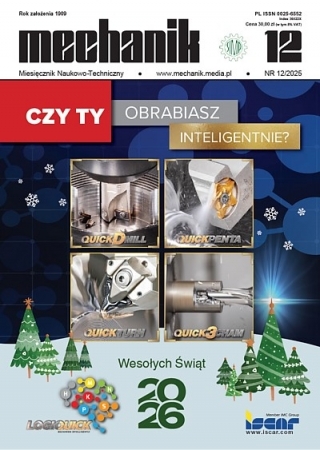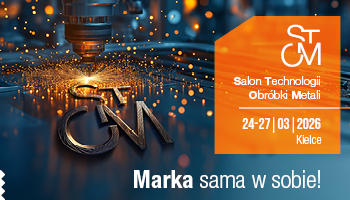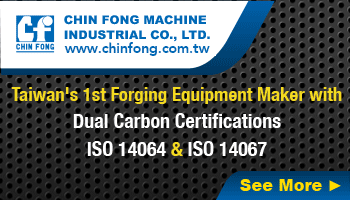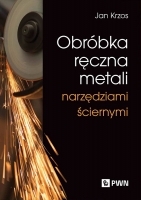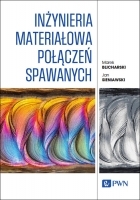Wpływ konstrukcji urządzeń do tworzenia mgły emulsyjnej na chropowatość powierzchni obrobionej po procesie skrawania stali C45
The impact of the design of emulsion mist generating devices on the machined surface roughness after the cutting process of C45 steel
Mechanik nr 08/09/2015 - Wersje autorskie artykułów z IX Konferencji Szkoły Obróbki Skrawaniem zamieszczone na płycie CD
STRESZCZENIE: Zaprezentowano budowę i zasadę działania dwóch urządzeń wykorzystywanych podczas obróbki z minimalnym chłodzeniem i smarowaniem. Podano wartości wejściowych parametrów tworzenia mgły emulsyjnej dla urządzenia GAV 1500 i Micronizer Lenox (przepływ objętościowy powietrza i przepływ masowy emulsji). Wybrane parametry chropowatości uzyskane dla powierzchni obrobionej metodą MQCL poddano analizie regresyjnej i porównano z wynikami obróbki na sucho.
SŁOWA KLUCZOWE: urządzenie do tworzenia mgły emulsyjnej, metoda MQCL, obróbka na sucho, chropowatość powierzchni obrobionej
ABSTRACT: The paper presents the design and principle of operation of two devices used during machining with minimum cooling and lubrication. The input parameter values for emulsion mist generation for the GAV 1500 and Micronizer Lenox device (air volume flow and emulsion mass flow) were given. The assorted roughness parameters obtained for a surface machined with the MQCL method were subject to regression analysis and compared with results of dry machining.
KEYWORDS: emulsion mist generation device, MQCL methods, dry machining, machined surface roughness
BIBLIOGRAFIA / BIBLIOGRAPHY:
- KRAMAR D., SEKULIČ M., JURKOVIČ Z., KOPAČ J., The machinability of nickel-based alloys in high-pressure jet assisted (HPJA) turning. Metalurgija, 52 (2013) 4, 512-514.
- PUSAVEC F, KRAMAR D, KRAJNIK P, KOPAČ J., Transitioning to sustainable production – part II: evaluation of sustainable machining technologies. Journal of Cleaner Production, 18 (2010) 12, 1211-1221.
- ADLER D.P., HII W.S., MICHALEK D.J., SUTHERLAND J.W., Examining the role of gutting fluids and efforts to address associated anviromental/health concerns. Machining Science and Technology, 10 (2006) 1, 23-58.
- HADAD M., SADEGHI B., Minimum quantity lubrication-MQL turning of AISI 4140 steel alloy. Journal of Cleaner Production, 54 (2013), 332-343.
- LEPPERT T., Effect of cooling and lubrication conditions on surface topography and turning process of C45 steel. International Journal of Machine Tools and Manufacture, 51 (2011), 120-126.
- RAHMAN M., SENTHIL KUMAR A., SALAM M.U., Experimental evaluation on the effect of minimal quantities of lubricant in milling. International Journal of Machine Tools and Manufacture, 42 (2002) 5, 539-547.
- KALITA P., MALSHE A.P., KUMAR S.A., YOGANATH V.G., GURUMURTHY T., Study of specific energy and friction coefficient in minimum quantity lubrication grinding using oil-based nanolubricants. Journal of Manufacturing Processes, 14 (2012), 160-166.
- RAHIM E.A., SASAHARA H., A study of the effect of palm oil as MQL lubricant on high speed drilling of titanium alloys. Tribology International, 44 (2011), 309-317.
- SARIKAYA M., GÜLLÜ A., Taguchi design and response surface methodology based analysis of machining parameters in CNC turning under MQL. Journal of Cleaner Production, 65 (2014), 604-616.
- SANCHEZ J.A., POMBO I., ALBERDI R., IZQUIERDO B., ORTEGA N., PLAZA S., MARTINEZ-TOLEDANO J., Machining evaluation of a hybrid MQL-CO2 grinding technology. Journal of Cleaner Production, 18 (2010), 1840-1849.
- HADAD M., SADEGHI B., Minimum quantity lubrication-MQL turning of AISI 4140 steel alloy. Journal of Cleaner Production, 54 (2013), 332-343.
- MARUDA R.W., LEGUTKO S., KROLCZYK G.M., Influence of Minimum Quantity Cooling Lubrication (MQCL) on chip formation zone factors and shearing force in turning AISI 1045 steel. Applied Mechanics and Materials, 657 (2014), 43-47.
- HÄNLE P., GSÄNGER D., MMS – gerechte Gestaltung des Bohrenschaftes. Werkstatt und Betrieb, 136 (2003), s 54-56.
- TAWAKOLI T., HADAD M.J., SADEGHI M.H., Influence of oil mist parameters on minimum quantity lubrication–MQL grinding proces. International Journal of Machine Tools & Manufacture, 50 (2010), 521-531.
- PAULO DAVIM J., Machining. Fundamentals and Recent Advances, London, Springer-Verlag London Limited, 2008.
- STATNIKOV R.B., STATNIKOV A., The Parameter Space Investigation Method Toolkit, Artech House, Boston/London, 2011.
- FELDSHTEIN E., MARUDA R., Zastosowanie metody "Parameter Space Investigation" w planowaniu badań inżynierskich (na przykładzie badań chropowatości), Mechanik, 8-9 (2013), 403-409.




